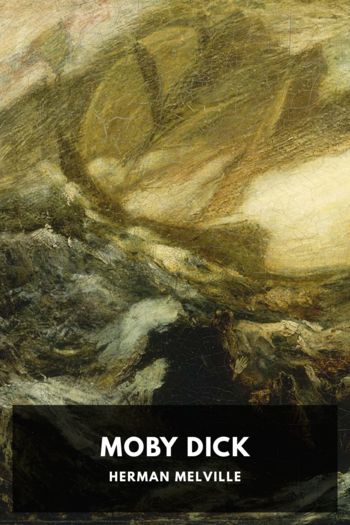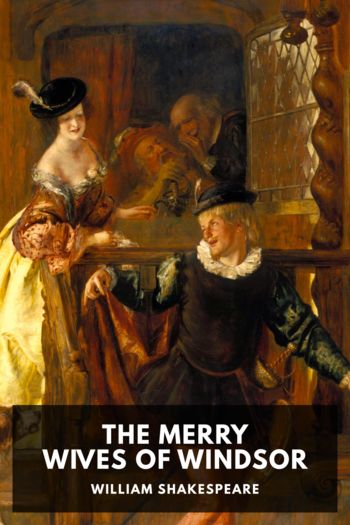Moby Dick, Herman Melville [books for 10th graders TXT] 📗

- Author: Herman Melville
Book online «Moby Dick, Herman Melville [books for 10th graders TXT] 📗». Author Herman Melville
Here are his reflections some time after quitting the ship, during a black night in an open boat, when almost despairing of reaching any hospitable shore. “The dark ocean and swelling waters were nothing; the fears of being swallowed up by some dreadful tempest, or dashed upon hidden rocks, with all the other ordinary subjects of fearful contemplation, seemed scarcely entitled to a moment’s thought; the dismal looking wreck, and the horrid aspect and revenge of the whale, wholly engrossed my reflections, until day again made its appearance.”
In another place—p. 45—he speaks of “the mysterious and mortal attack of the animal.” ↩
The cabin-compass is called the telltale, because without going to the compass at the helm, the Captain, while below, can inform himself of the course of the ship. ↩
The ancient whale-cry upon first sighting a whale from the masthead, still used by whalemen in hunting the famous Gallipagos terrapin. ↩
That part of the sea known among whalemen as the “Brazil Banks” does not bear that name as the Banks of Newfoundland do, because of there being shallows and soundings there, but because of this remarkable meadow-like appearance, caused by the vast drifts of brit continually floating in those latitudes, where the Right Whale is often chased. ↩
It will be seen in some other place of what a very light substance the entire interior of the sperm whale’s enormous head consists. Though apparently the most massive, it is by far the most buoyant part about him. So that with ease he elevates it in the air, and invariably does so when going at his utmost speed. Besides, such is the breadth of the upper part of the front of his head, and such the tapering cut-water formation of the lower part, that by obliquely elevating his head, he thereby may be said to transform himself from a bluff-bowed sluggish galliot into a sharppointed New York pilot-boat. ↩
Partly to show the indispensableness of this act, it may here be stated, that, in the old Dutch fishery, a mop was used to dash the running line with water; in many other ships, a wooden piggin, or bailer, is set apart for that purpose. Your hat, however, is the most convenient. ↩
A little item may as well be related here. The strongest and most reliable hold which the ship has upon the whale when moored alongside, is by the flukes or tail; and as from its greater density that part is relatively heavier than any other (excepting the side-fins), its flexibility even in death, causes it to sink low beneath the surface; so that with the hand you cannot get at it from the boat, in order to put the chain round it. But this difficulty is ingeniously overcome: a small, strong line is prepared with a wooden float at its outer end, and a weight in its middle, while the other end is secured to the ship. By adroit management the wooden float is made to rise on the other side of the mass, so that now having girdled the whale, the chain is readily made to follow suit; and being slipped along the body, is at last locked fast round the smallest part of the tail, at the point of junction with its broad flukes or lobes. ↩
The whaling-spade used for cutting-in is made of the very best steel; is about the bigness of a man’s spread hand; and in general shape, corresponds to the garden implement after which it is named; only its sides are perfectly flat, and its upper end considerably narrower than the lower. This weapon is always kept as sharp as possible; and when being used is occasionally honed, just like a razor. In its socket, a stiff pole, from twenty to thirty feet long, is inserted for a handle. ↩
The monkey-rope is found in all whalers; but it was only in the Pequod that the monkey and his holder were ever tied together. This improvement upon the original usage was introduced by no less a man than Stubb, in order to afford the imperilled harpooneer the strongest possible guarantee for the faithfulness and vigilance of his monkey-rope holder. ↩
This reminds us that the Right Whale really has a sort of whisker, or rather a moustache, consisting of a few scattered white hairs on the upper part of the outer end of the lower jaw. Sometimes these tufts impart a rather brigandish expression to his otherwise solemn countenance. ↩
Quoin is not a Euclidean term. It belongs to the pure nautical mathematics. I know not that it has been defined before. A quoin is a solid which differs from a wedge in having its sharp end formed by the steep inclination of one side, instead of the mutual tapering of both sides. ↩
Though all comparison in the way of general bulk between the whale and the elephant is preposterous, inasmuch as in that particular the elephant





Comments (0)